The national flag of the Republic of Namibia is a visually striking and deeply meaningful emblem, serving as a powerful testament to the nation's arduous struggle for independence, its rich natural resources, and its profound aspirations for peace, unity, and prosperity. Adopted on March 21, 1990, the very day Namibia gained full independence from South Africa after a long and protracted liberation struggle, its design was meticulously chosen to embody the unique identity and shared future of its diverse people. The dynamic diagonal band, vibrant colors, and central sun symbol narrate a compelling story of resilience, hope, and national pride.
Design and Symbolism: A Dynamic Portrayal of National Identity
The flag of Namibia features a broad, diagonal stripe of red, edged in thin white bands, running from the lower hoist (left) corner to the upper fly (right) corner. The upper triangle formed by this diagonal band is blue, and the lower triangle is green. In the upper hoist corner, a golden sun with twelve triangular rays is emblazoned. Each element of the flag carries significant symbolic meaning, reflecting Namibia's landscape, history, and national ethos:
-
Blue Triangle (Upper Hoist): The vibrant blue color represents the sky, the Atlantic Ocean, and the precious water resources of Namibia, particularly the rain. Water is a vital element for life and development in this largely arid country, and the blue signifies the importance of these resources for the nation's future. It also symbolizes hope and the endless possibilities that lie ahead for the newly independent state.
-
Red Diagonal Stripe: The broad red diagonal stripe, stretching across the flag, symbolizes the heroism of the Namibian people and their determination to build a future of equal opportunity. It specifically represents the blood shed during the long and arduous struggle for liberation from colonial oppression. It is a powerful reminder of the sacrifices made to achieve freedom and self-determination.
-
Green Triangle (Lower Fly): The rich green color in the lower triangle represents Namibia's natural resources, its vast agricultural lands, and its lush vegetation. Namibia is blessed with a diverse landscape, from the fertile northern regions to the productive farmlands. Green signifies growth, vitality, and prosperity, reflecting the nation's potential for economic development and the well-being of its people.
-
White Fimbriations (Edges of Red Stripe): The thin white bands that border the red diagonal stripe symbolize peace and unity. They represent the call for racial harmony and the desire for all Namibians to live together peacefully, regardless of their background, fostering a sense of shared national identity after decades of segregation. White universally conveys purity and a commitment to a peaceful future.
-
Golden Sun with Twelve Rays (Upper Hoist): The prominent golden sun, positioned in the blue triangle, is arguably the most recognizable and powerful symbol on the flag.
-
Golden Color: Represents the desert and the valuable mineral resources of Namibia, such as diamonds, gold, and uranium, which are significant contributors to the nation's economy. It also signifies life and energy.
-
Twelve Rays: The twelve triangular rays radiating from the sun are highly symbolic. They are believed to represent the twelve major ethnic groups or tribes of Namibia, emphasizing the nation's commitment to unity in diversity. The sun's position in the blue sky (upper hoist) signifies life and energy illuminating the nation's aspirations.
The combination of these colors and symbols creates a flag that is not only visually dynamic but also deeply resonant with the history, challenges, and aspirations of the Namibian people.
Dimensions and Proportions:
The official proportions of the Flag of Namibia are a width-to-length ratio of 2:3. This is a common ratio for national flags, giving it a balanced and aesthetically pleasing appearance. The diagonal red stripe, bordered by white, divides the flag precisely. The golden sun emblem in the upper hoist corner is typically proportioned to occupy a significant portion of the blue triangle, with its diameter and ray length precisely defined in the flag's specifications to ensure consistency.
History and Evolution: A Symbol Born of Liberation
The history of the Namibian flag is inextricably linked to the country's long and arduous struggle for independence, particularly against South African apartheid rule.
-
Colonial Era (Pre-1990): Prior to 1990, Namibia (then known as South West Africa) was administered by South Africa, which had effectively annexed the territory. The flags flown were primarily those of South Africa (including the apartheid-era flag) or, to a lesser extent, the flag of the South West African People's Organisation (SWAPO), which spearheaded the independence movement.
-
SWAPO Flag: The SWAPO flag was itself a horizontal tricolor of blue, red, and green, which were later incorporated into the national flag. Blue represented the sky, the Atlantic Ocean, and Namibia's mineral resources; red symbolized the struggle and the sacrifices made; and green represented agriculture and vegetation.
-
Path to Independence (Late 1980s): As negotiations for Namibia's independence gained momentum in the late 1980s, the need for a national flag became paramount.
-
Design Competition and Adoption (1990): A national competition was launched to solicit designs for the new national flag. Over 835 entries were submitted. While no single entry was adopted entirely, the final design was a synthesis of proposals by three individuals: Frederick Brownell (a South African heraldist who also designed the South African flag), Don Stevenson, and Theo Karstensen. The colors were specifically chosen to reflect the colors of the SWAPO flag, as well as the Democratic Turnhalle Alliance (DTA), another political party, symbolizing reconciliation and national unity.
-
Inauguration: The current flag was officially hoisted for the first time on March 21, 1990, at the solemn independence ceremony in Windhoek, marking the birth of the sovereign Republic of Namibia. This moment was deeply emotional and significant for a nation that had endured decades of colonial rule and struggle.
-
Unchanged Since Independence: The flag has remained unchanged since its adoption, serving as a constant symbol of the nation's hard-won freedom and its commitment to the principles enshrined in its design.
Regional Context and Southern African Identity:
Namibia is located in Southern Africa, bordering Angola, Zambia, Botswana, and South Africa, with a long coastline on the Atlantic Ocean. Its flag, while unique in its design, shares some thematic connections with other flags in the Southern African Development Community (SADC) and the broader African continent.
Many African flags, especially those of former colonies, often incorporate colors that symbolize liberation struggles (red), natural resources (green/gold), water (blue), and peace/unity (white/black). Namibia's flag effectively synthesizes these themes. The use of blue, red, green, and gold (yellow) are common in flags across the continent, often referred to as Pan-African colors, though Namibia's arrangement and the specific symbolism (especially the twelve rays) are distinctive. The flag visually asserts Namibia's place within the diverse tapestry of African nations, while simultaneously emphasizing its unique journey to independence and its particular environmental and cultural characteristics. It stands as a proud emblem among its neighbors, signifying a shared history of decolonization but a unique path forward.
Interesting Facts:
-
Born on Independence Day: The flag was adopted and first hoisted on March 21, 1990, the very day of Namibia's independence.
-
Synthesis of Designs: The final design was a combination of ideas from multiple submissions, rather than a single winning entry.
-
Colors from SWAPO Flag: The core colors (blue, red, green) are derived from the flag of the South West African People's Organisation (SWAPO), the liberation movement.
-
Represents Reconciliation: The inclusion of white fimbriations and the specific arrangement of colors were also intended to represent reconciliation between different political factions and ethnic groups.
-
Sun with 12 Rays: The golden sun with twelve rays is highly symbolic, often interpreted as representing Namibia's twelve major ethnic groups, highlighting unity in diversity.
-
Symbol of Hope and Resilience: For many Namibians, the flag is a powerful symbol of the nation's resilience and its hope for a prosperous future after decades of struggle.
-
Unique Diagonal Design: Its dynamic diagonal design makes it visually distinct among world flags.
-
Frederick Brownell's Contribution: A South African, Frederick Brownell, who also designed the South African flag, was instrumental in finalizing the Namibian flag design.
Significance for the Inhabitants: A Banner of Freedom, Unity, and Aspiration
For the people of Namibia, their national flag is more than just a piece of fabric; it is a profound and emotionally charged symbol of their hard-won freedom, their shared national identity, and their collective aspirations. It embodies the sacrifices of the past, the realities of the present, and the hopes for the future.
The red diagonal band is a poignant reminder of the blood shed by those who fought tirelessly for liberation. It instills a deep sense of respect and gratitude for the heroes and heroines who paved the way for independence. The white fimbriations, flanking the red, speak to the dream of peace and reconciliation, a particularly resonant message in a nation that emerged from a history of racial segregation and conflict. They represent the commitment of all Namibians to build a harmonious society together.
The blue triangle, symbolizing the sky, ocean, and water, highlights the preciousness of resources in an arid land and evokes a sense of hope for sustained development. The green triangle, representing the land's bounty, instills pride in Namibia's natural wealth and its potential for agricultural prosperity.
The golden sun, radiating its twelve rays, is a powerful unifying symbol. It represents the life-giving energy of the sun in the desert landscape, and more importantly, the unity of Namibia's diverse population. It reminds every citizen that they are an integral part of the nation, and that their collective strength lies in their diversity.
When the flag is raised, whether during national holidays, sporting events, or everyday life, it evokes a powerful sense of patriotism, belonging, and shared purpose. It is a beacon of their sovereignty, their commitment to democracy, and their collective dream of a unified, prosperous, and peaceful Namibia, standing tall among the nations of the world.
In the demonstration images, full-size flags are shown with proportions of 2:3, and hand-held flags with proportions of 1:2.
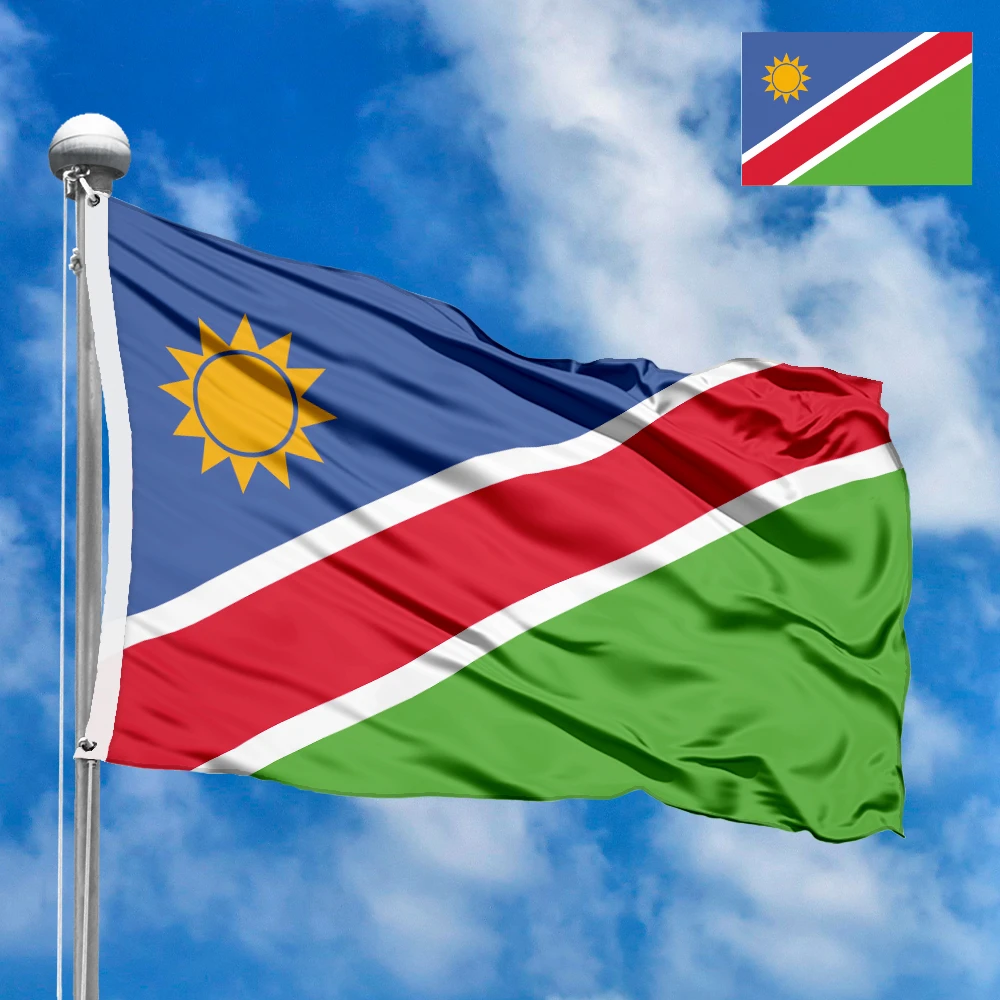

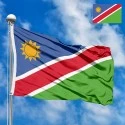
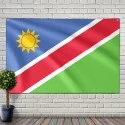
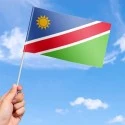

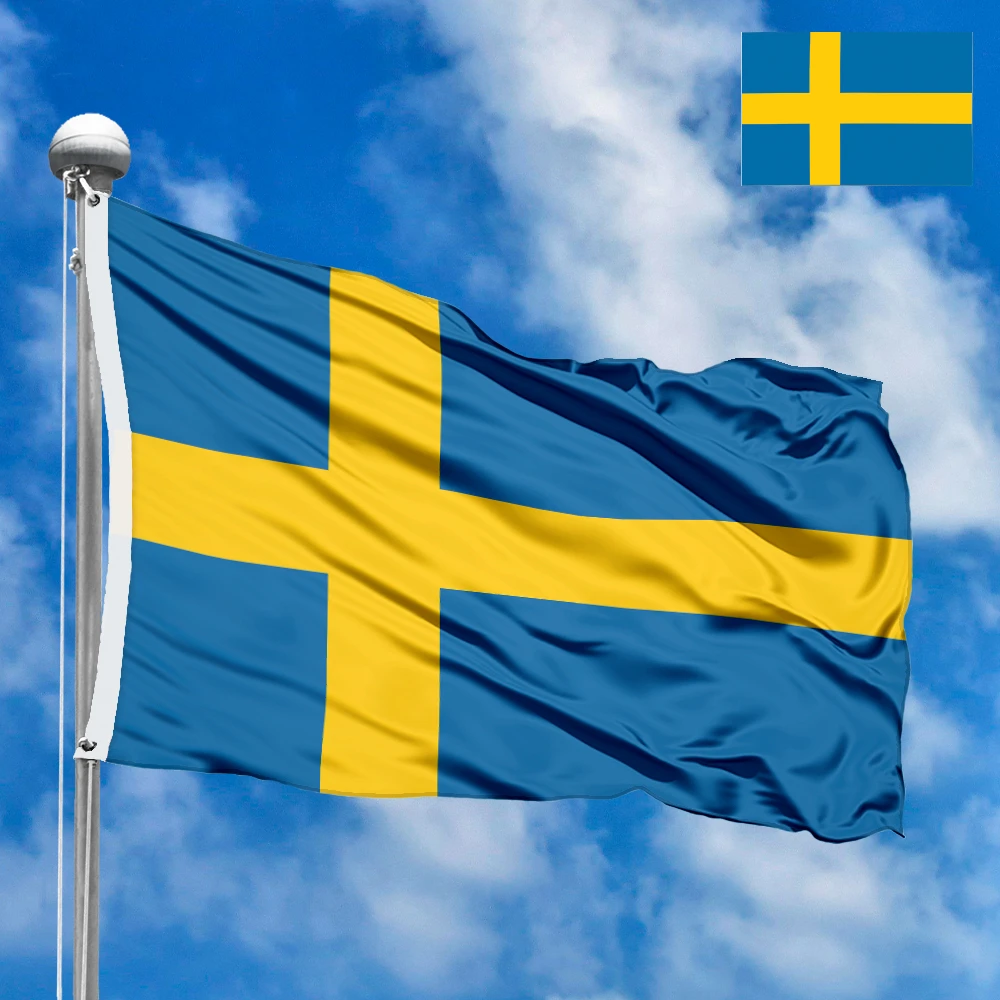

 Waving flag
Waving flag
 Sizes:
Sizes:
 Round flag
Round flag
 Sizes:
Sizes:
 Rectangular flag 2:3
Rectangular flag 2:3
 Sizes:
Sizes: